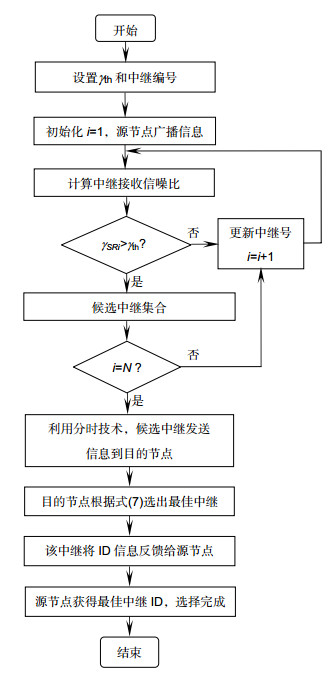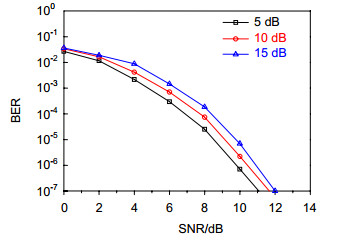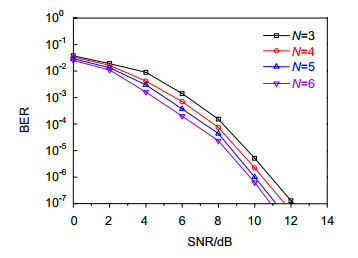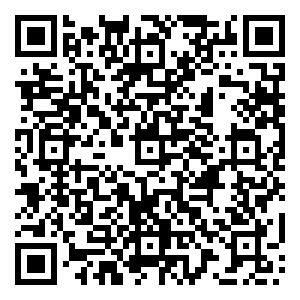-
摘要
针对装甲编队在复杂战场环境下的紫外光端到端通信中断问题,多采用中继辅助方式建立协作通信链路,而中继选择是关键问题之一。为了提高编队之间的通信协同能力,在解码转发协议的前提下,结合门限决策思想,提出了一种基于无线紫外光隐秘通信的装甲编队最佳中继选择算法。该算法结合紫外光非直视通信的优点,根据信噪比门限和信道特性的选择策略,对编队进行最佳中继的选择,并在高斯噪声模型下,分析了其误码率性能。仿真结果表明,在根据不同的信噪比环境和中继数来选取适当的协作门限,可获得最佳中继链路,以及在协作通信链路动态变化时,调整中继的接收和发射状态,能有效提高协作中继链路的通信质量。

Abstract
In view of the end-to-end communication interruption problem of armored formations in complex battlefield environments, relay-assisted methods are often used to establish cooperative communications links, and the choice of relay is a key issue. In order to improve the communication coordination ability among formations, an optimal relay selection algorithm for armored formations based on wireless ultraviolet (UV) covert communication is proposed on the premise of decode-and-forward protocol, combined with the threshold decision idea. The algorithm combines the advantages of UV NLOS(non-line-of-sight) communication. The optimal relay selection is made for the formations according to the signal-to-noise ratio (SNR) threshold and channel characteristics selection strategy, and the bit error rate (BER) performance is analyzed under Gaussian noise model. The simulation results show that the optimal relay link can be obtained by selecting the appropriate cooperation threshold according to different SNR environments and relay number. Furthermore, adjusting the receiving and transmitting status of the relay, when the cooperative communications link changes dynamically, can effectively improve the communication quality of the cooperative relay link.
-
Overview

Overview: In the battlefield environment of complex terrain, the use of ultraviolet (UV) communication in armored formations overcomes the shortcomings of cable laying. And due to the strong absorption of atmosphere, UV communication have low identification rate performance, which has better covert transmission performance than other wireless communication modes such as infrared optical communication and radio frequency communication. Because of the serious attenuation of the UV atmospheric channel and high path loss, the end-to-end communication between the formations is easily interrupted, and the receiving end cannot receive the combat missions in time, which affects the combat capability of the formation. In order to improve the cooperative communications ability between the armored formations and the end-to-end communication quality of UV, how to select a reliable single relay node for the cooperative communications system of the UV NLOS (non-line-of-sight) multi-relay parallel link is studied.
The optimal relay selection algorithm for armored formations based on wireless UV covert communication is proposed on the premise of decode-and-forward protocol, combined with the threshold decision idea. The algorithm combines the advantages of UV NLOS communication. The optimal relay selection is made for the formations according to the signal to noise ratio (SNR) threshold and channel characteristics selection strategy, and the bit error rate (BER) performance is analyzed under Gaussian noise model. It can be seen from the simulation results that the BER performance of the UV cooperative communications system is affected by the threshold, the relay geometry and the relay position. Under the condition of higher signal to noise ratio and fewer candidate relay nodes, the cooperation threshold can be appropriately reduced to improve the system BER performance. Therefore, the algorithm can select appropriate coordination thresholds according to different SNR environments and the number of relay nodes, and select the best relay to establish a UV NLOS relay cooperative communications link. When the relay node selects a narrow transmitter and receiving apex angle as well as a wide receiving FOV, the relay closer to the source node becomes preferable. Therefore, when the cooperative communications link changes dynamically, the receiving and transmitting states of the relay node is adjusted according to the distance from the cooperative relay node to the source node. This enables the cooperative communications system to obtain the best BER performance, enhance the invulnerability of the cooperative communications links, and meet the communication needs of armored formations in complex battlefield environments.
-

-
表 1 系统主要仿真参数
Table 1. Main simulation parameters of system
参数 值 紫外波长/nm 260 发射功率/mW 10 接收孔径面积/cm2 1.8 吸收系数/km-1 0.802 米氏散射系数/km-1 0.284 瑞利散射系数/km-1 0.266 βTxS, θTxS, θTxR/(°) 30, 15, 15 βRxD, θRxD/(°) 40, 60 数据速率Rc/(kbit·s-1) 1 表 2 θRxR=60°,bTxR=30°不同中继接收仰角的最佳中继位置
Table 2. Optimal relay location for different relay receiving apex angle for θRxR=60°, βTxR=30° m
中继接收仰角/(°) SD=600 SD=800 SD=1000 30 200 300 400 40 200 300 300 45 200 200 300 60 150 200 300 表 3 βRxR=40°,bTxR=30°不同中继接收视场角的最佳中继位置
Table 3. Optimal relay location for different relay receiving FOV for βRxR=40°, βTxR=30° m
中继接收视场角/(°) SD=600 SD=800 SD=1000 45 200 200 300 60 200 300 300 80 250 300 400 表 4 βRxR=40°, θRxR=60°不同中继发射仰角的最佳中继位置
Table 4. Optimal relay location for different relay transmitter apex angle for βRxR=40°, θRxR=60° m
中继发射仰角/(°) SD=600 SD=800 SD=1000 30 200 300 300 40 250 300 400 45 250 400 400 60 300 400 500 -
参考文献
[1] 赵太飞, 王小瑞, 柯熙政.多LED紫外光通信系统设计与性能分析[J].红外与激光工程, 2012, 41(6): 1544-1549. doi: 10.3969/j.issn.1007-2276.2012.06.027
Zhao T F, Wang X R, Ke X Z. Design and performance analysis of multi-LEDs UV communication system[J]. Infrared and Laser Engineering, 2012, 41(6): 1544-1549. doi: 10.3969/j.issn.1007-2276.2012.06.027
[2] 许强.军用紫外探测技术及应用[M].北京:北京航空航天大学出版社, 2010.
[3] Vavoulas A, Sandalidis H G, Varoutas D. Connectivity issues for ultraviolet UV-C networks[J]. Journal of Optical Communications and Networking, 2011, 3(3): 199-205. doi: 10.1364/JOCN.3.000199
[4] Zhao T F, Gao Y Y, Zhang Y. An area coverage algorithm for non-line-of-sight ultraviolet communication network[J]. Photonic Network Communications, 2016, 32(2): 269-280. doi: 10.1007/s11107-016-0622-7
[5] 武梦龙.宽带无线光通信关键技术研究[D].北京: 北京邮电大学, 2015.
Wu M L. Research on key techniques of broadband optical wireless communications[D]. Beijing: Beijing University of Posts and Telecommunications, 2015.
[6] 丁莹, 范静涛, 佟首峰, 等.大气信道紫外光通信系统通信距离的增程方法[J].光子学报, 2012, 41(9): 1047-1052. http://d.old.wanfangdata.com.cn/Periodical/gzxb201209008
Ding Y, Fan J T, Tong S F, et al. Approach of distance improving of atmospheric UV communication[J]. Acta Photonica Sinica, 2012, 41(9): 1047-1052. http://d.old.wanfangdata.com.cn/Periodical/gzxb201209008
[7] 唐义, 倪国强, 张丽君, 等.非直视紫外光通信单次散射传输模型研究[J].光学技术, 2007, 33(5): 759-762, 765. doi: 10.3321/j.issn:1002-1582.2007.05.043
Tang Y, Ni G Q, Zhang L J, et al. Study of single scatter model in NLOS UV communication[J]. Optical Technique, 2007, 33(5): 759-762, 765. doi: 10.3321/j.issn:1002-1582.2007.05.043
[8] He Q F, Xu Z Y, Brian M S. Non-line-of-sight serial relayed link for optical wireless communications[C]//Proceedings of Milcom 2010 Military Communications Conference, San Jose, CA, USA, 2010: 1588-1593.
10.1109/MILCOM.2010.5680180 [9] Gong C, Xu Z Y. Non-line of sight optical wireless relaying with the photon counting receiver: a count-and-forward protocol[J]. IEEE Transactions on Wireless Communications, 2015, 14(1): 376-388. doi: 10.1109/TWC.2014.2347302
[10] Ardakani M H, Uysal M. Relay-assisted OFDM for ultraviolet communications: performance analysis and optimization[J]. IEEE Transactions on Wireless Communications, 2017, 16(1): 607-618. doi: 10.1109/TWC.2016.2626438
[11] Ardakani M H, Heidarpour A R, Uysal M. Performance analysis of relay-assisted NLOS ultraviolet communications over turbulence channels[J]. Journal of Optical Communications and Networking, 2017, 9(1): 109-118. doi: 10.1364/JOCN.9.000109
[12] Ardakani M H, Uysal M. Relay-assisted OFDM for NLOS ultraviolet communication[C]//Proceedings of the 2015 17th International Conference on Transparent Optical Networks, Budapest, Hungary, 2015: 1-4.
10.1109/ICTON.2015.7193339 [13] He Q F, Xu Z Y, Sadler B M. Performance of short-range non-line-of-sight LED-based ultraviolet communication receivers[J]. Optics Express, 2010, 18(12): 12226-12238. doi: 10.1364/OE.18.012226
[14] Chen G, Xu Z Y, Ding H P, et al. Path loss modeling and performance trade-off study for short-range non-line-of-sight ultraviolet communications[J]. Optics Express, 2009, 17(5): 3929-3940. doi: 10.1364/OE.17.003929
[15] 罗畅.非视距光通信信号处理研究与基带系统设计[D].北京: 中国科学院研究生院(空间科学与应用研究中心), 2011.
Luo C. The study of signal processing and design of base band system for non-line-of-sight optical communication[D]. Beijing: Graduate School of Chinese Academy of Sciences (Center for Space Science and Applied Research), 2011.
[16] Kahn J M, Krause W J, Carruthers J B, et al. Experimental characterization of non-directed indoor infrared channels[J]. IEEE Transactions on Communications, 1995, 43(2-4): 1613-1623. http://www.wanfangdata.com.cn/details/detail.do?_type=perio&id=06ec195cc95a34ec87ce6f73f909bb3d
[17] 赵明宇.紫外光通信大气传输特性和调制技术研究[D].北京: 北京邮电大学, 2013.
Zhao M Y. Characteristics of atmospheric propagation and modulation research for UV communication[D]. Beijing: Beijing University of Posts and Telecommunications, 2013.
[18] 张爱利.无线紫外光通信链路性能研究[D].西安: 西安理工大学, 2014.
Zhang A L. Research on the performance of wireless ultraviolet communication link[D]. Xi'an: Xi'an University of Technology, 2014.
-
访问统计


 E-mail Alert
E-mail Alert RSS
RSS
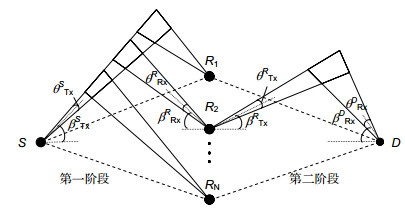
 下载:
下载:
